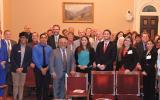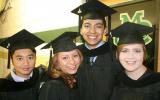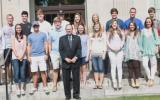Innovations
March
2016
Community colleges throughout the United States serve students from a variety of backgrounds. Many of these students need assistance to successfully navigate the course enrollment and financial aid processes, and to complete their chosen degree or certification programs. Strong academic advisement is essential to students’ abilities to navigate course requirements, financial aid requirements, and degree expectations (Strayhorn, 2015). Structuring and implementing a strong advisement process requires a multifaceted, collaborative approach that includes input from advisement staff and faculty,...
Tags:
March
2016
Community colleges throughout the United States serve students from a variety of backgrounds. Many of these students need assistance to successfully navigate the course enrollment and financial aid processes, and to complete their chosen degree or certification programs. Strong academic advisement is essential to students’ abilities to navigate course requirements, financial aid requirements, and degree expectations (Strayhorn, 2015). Structuring and implementing a strong advisement process requires a multifaceted, collaborative approach that includes input from advisement staff and faculty,...
Tags:
March
2016
Community colleges throughout the United States serve students from a variety of backgrounds. Many of these students need assistance to successfully navigate the course enrollment and financial aid processes, and to complete their chosen degree or certification programs. Strong academic advisement is essential to students’ abilities to navigate course requirements, financial aid requirements, and degree expectations (Strayhorn, 2015). Structuring and implementing a strong advisement process requires a multifaceted, collaborative approach that includes input from advisement staff and faculty,...
Tags:

Last September, Chandler-Gilbert Community College (CGCC) was awarded a Latino Americans: 500 Years of History grant from the National Endowment for the Humanities (NEH) and the American Library Association (ALA). As one of 203 grant recipients selected from across the country, CGCC received an award of $10,000 to produce public programming about Latino history and culture.
Beginning last fall, CGCC began hosting a variety of program activities to engage students and the community about the history and cultural impact of Latinos in the United States. Activities featured a Latino American art...
Tags:

A bachelor’s degree in criminal justice paved the way for Leticia Cervantes to become a licensed private investigator. But after a few years in the business, usually checking on unfaithful spouses for local attorneys, she craved a more reliable income and regular work hours. Her solution: Go back to school and learn cosmetology.
“I made the move because the economy is so unpredictable,” said Cervantes, 37, who in December received a certificate in cosmetology from Del Mar College. “My sister has always taught me that in times of economic crisis, people won’t hire a private investigator, but...
Tags:

For the nine community colleges in California’s San Diego and Imperial counties, “strength in numbers” is more than just an axiom. Through combining their forces—and their voices—college leaders have found that they are able to deliver a powerful message to legislators, the media, and the public.
Representatives from the San Diego and Imperial County colleges meet monthly as part of a consortium known as the San Diego and Imperial Counties Community College Association (SDICCCA). The six college districts, serving a total of more than 200,000 students, range from the San Diego district, the...
Tags:

In the fall of 2009, the first cohort of more than 100 ninth-grade students were admitted into Early College High School at Midland College (ECHS@MC). The school focuses primarily on serving first-generation college students, those with a low socioeconomic status, and/or those whose ethnicities are underrepresented at the college level.
Today, Midland College (MC) and the Midland Independent School District (MISD) have recognized three cohorts of graduates from the successful program. Over 85 percent of those students received associate degrees from Midland College at the same time they...

American College Testing, with over fifty years of college readiness research, defines college readiness as students having “a 50% chance of obtaining a B or higher or about a 75% chance of obtaining a C or higher in the corresponding credit-bearing college courses, which include English Composition, Algebra, Social Science and Biology” (ACT, 2012, p. 3). Unfortunately, the majority of students graduating from high school are not college ready, and the need for improvement in the American high school educational structure is clear. Test results from 2015 give the percentage of high school...
January
2016
Two things posted last fall in Inside Higher Ed (week of 11/15/2015) caught my eye about college completion. The US Department of Education has submitted proposal language giving them the authority to force accrediting agencies from approving colleges where students are not completing at acceptable rates. At the same time, the National Student Clearinghouse is reporting decreasing numbers of student completing across the board in higher education. Before us then is the big problem: Student completion is a huge agenda in most circles and try as we might, it is tough to improve the rates at...
Tags:
January
2016
“California dreaming” is a theme in American folklore. California’s Upward-Mobility Machine (David Leonhardt, The New York Times, Sept. 16, 2015), discussed how educational opportunities in the Golden State provide a catalyst for economic empowerment. “The big challenge for American higher education,” said the chancellor at the UC Irvine, “is that it has to be a gateway through which talented young people can thrive, regardless of their background.”
In this regard, California is a national leader. As the College Access Index indicated, a measure of economic diversity at institutions of higher...
Tags:
January
2016
Student Success is certainly on our collective mind these days.
On community college campuses we have long been concerned about our students and working with them to achieve their goals. I expect that nearly all colleges have specific efforts underway, falling under the big category of Student Success. Faculty are definitely critical to the execution of these efforts and thankfully many have stepped up to provide leadership in the work.
As a faculty leader on your campus focusing on students and improving their success—including their staying around to complete a degree or certificate—...
Tags:
January
2016
At the end of each workday, when American community college educators reflect on their day, it’s the little successes and setbacks that stand out.
I got my papers graded before dinner? Cool!
The student who flunked the last exam just turned in a great assignment? Awesome!
The electricity went out just as I was presenting today? Chocolate – stat!
My point is that these daily high notes and low notes are loud in an educator’s life. By comparison, the voices of policy makers and college leaders calling for student success and completion can seem like a distant Greek chorus. It is natural to...
Tags:

Snead State Community College began its Presidential Scholars program in 2009 as a leadership development opportunity for incoming students who demonstrated academic excellence. Including the 2015-2016 group, 62 students have received the distinction of Presidential Scholars, and the graduation rate among those completing courses at SSCC is 97 percent.
Presidential Scholars represent Snead State at a variety of events, including donor recognition and alumni functions. The students participate in two signature activities each year—completion of the BOLD team building ropes course at Berry...
Tags:

2016
Karen Hattaway, an English professor at San Jacinto College, discusses the Student Voice program at her college and how it contributes to student completion.
Tags:
December
2015
The Maricopa Community Colleges has announced a new program that will help children who are aging out of the foster care system to get into and complete college. The Bridging Success Initiative, funded by the Nina Mason Pulliam Charitable Trust, was introduced at an event with partners from across the Valley.
The initiative advisory board has representatives from Arizona State University (ASU), Children's Action Alliance, Arizona's Children Association, Arizona Friends of Foster Care, College Success Arizona, College Depot, Florence Crittendon, and the Arizona Department of Child Safety.
The...
Tags:
December
2015
In an historic meeting, Lake Land College and Eastern Illinois University trustees committed to building upon opportunities between the two institutions for the benefit of their students, communities, and state.
During the April 23, 2015, joint board meeting, trustees learned of the many partnerships the university and community college have developed over the past few decades. They also identified opportunities for future collaboration.
Located just 11 miles apart, the university, in Charleston, IL, and college, in Mattoon, IL, have a strong, supportive relationship. Students in East...
Tags:
December
2015
Established over thirty years ago to recognize significant community college innovations, the League’s Innovation of the Year awards are designed to honor faculty, staff, and administrators at member institutions who have created and implemented innovative programs, practices, partnerships, policies, and activities that improve the college’s ability to serve students and the community.
The following descriptions of four 2015 award-winning innovations reflect the diversity of programs and projects honored last year, which range from improving student success and promoting sustainable education...
Tags:
November
2015
Onondaga Community College (OCC), in Syracuse, New York, began educating the next wave of nuclear energy industry workers in the fall of 2013 when it became one of only 36 colleges in the country to offer an A.A.S. degree in Nuclear Energy Technology (NET). The program was created in direct response to a workforce demand brought to the college by the nuclear energy industry. It estimates approximately half of its workforce will be eligible to retire during the next 10 years. The program and its curriculum were funded initially by a grant from the U.S. Nuclear Regulatory Commission and a gift...
Tags:
November
2015
Dallas County Community College District (DCCCD) is having tremendous success in promoting completion and transfer among talented science, technology, engineering, and mathematics (STEM) students through the DCCCD STEM Institute. The Institute focuses on a crucial leakage point in the STEM pipeline—the freshman and sophomore years of college. Much of the movement out of STEM majors occurs in these pivotal first two years. Since its initiation in 2009, the STEM Institute has evolved to include comprehensive extracurricular support for students preparing to complete a bachelor’s degree or...
Tags:










